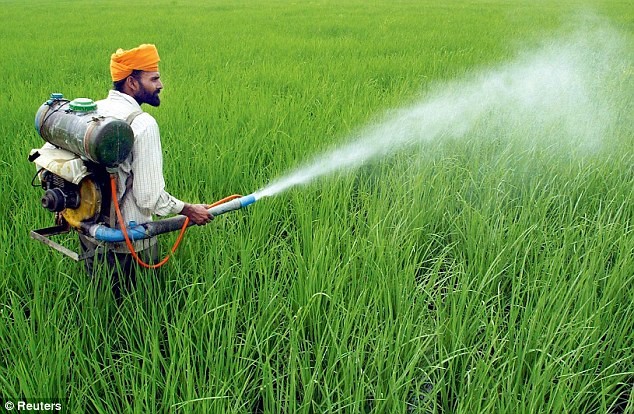Insecticides: Overview, Types, Uses and Benefits - A Comprehensive Guide
August 16, 2024What is Insecticides?
Insecticides
are a crucial arsenal in the battle against pests that threaten crops, health,
and the environment. These chemical compounds are specifically designed to
control and eliminate harmful insects, safeguarding agricultural produce and
promoting public health. Insecticides play an integral role in pest management
strategies, offering targeted solutions to various insect-related challenges.
Different Types of Insecticides
In
the world of pest management, a diverse array of insecticides exists to tackle
the various challenges posed by insect pests. These insecticides can be
categorized based on their chemical nature, mode of action, target insects, and
more. Let's explore the different dimensions of insecticides to gain a
comprehensive understanding of their classifications and uses.
1. Classification of Insecticides
Based on Chemical Nature
Insecticides
are often classified based on their chemical composition and origin. This
classification provides insights into the diversity of compounds utilized to
combat insect pests.
A. Synthetic Insecticides:
1. Synthetic: insecticides are chemically
formulated compounds developed to combat insect pests efficiently. They are
further categorized into different types, each with unique properties and modes
of action.
2. Organophosphates: These insecticides disrupt the
nervous systems of insects, causing paralysis and ultimately leading to death.
They are effective against a wide range of pests but require careful handling
due to their toxicity to humans and animals.
3. Pyrethroids: Pyrethroids are synthetic compounds
derived from natural pyrethrins found in chrysanthemum flowers. They act by
affecting insect nerve cells, leading to paralysis and death. Pyrethroids are
commonly used in household insecticides and agricultural applications.
4. Neonicotinoids: Neonicotinoids target insect nervous
systems, resulting in paralysis and death. They are often used as seed
treatments and are systemic, meaning the plants absorb and distribute the
chemical throughout their tissues.
B. Natural Insecticides
Natural
insecticides have emerged as a promising avenue in the quest for
environmentally friendly pest management solutions. Derived from organic
sources, these compounds offer a sustainable alternative to conventional
synthetic insecticides.
Let's
explore the types of natural insecticides and delve into their unique
attributes and applications.
1. Botanical Insecticides: Derived from
plant extracts, botanical insecticides offer a more environmentally friendly
alternative. Examples include neem oil, pyrethrin, and rotenone. These
compounds have minimal impact on non-target organisms and degrade more rapidly
in the environment.
2. Microbial Insecticides: These
insecticides consist of microorganisms, such as bacteria, viruses, and fungi
that infect and kill specific pests. Bacillus thuringiensis (Bt) is a
well-known microbial insecticide, targeting caterpillars and other leaf-eating
insects.
2. Classification of Insecticides
Based on Activity
Insecticides
are not one-size-fits-all solutions; they come in various forms tailored to
different pest control needs. One key aspect that distinguishes them is their
mode of activity. Some insecticides exert their effects upon direct contact,
while others operate systemically, impacting pests that consume treated plants.
Insecticides
can be classified based on their activity against pests:
1. Contact Insecticides: These insecticides are effective upon
direct contact with the target insect. They act quickly but may require
reapplication as they have limited residual activity.
2. Systemic Insecticides: Systemic
insecticides are absorbed by plants and spread throughout their tissues.
Insects feeding on treated plants ingest the insecticide, resulting in their
demise.
3. Classification of Insecticides
Based on Target Insects
The
world of insects is incredibly diverse, with various species posing distinct
challenges in different contexts. Insecticides have been developed to address
these challenges by targeting specific groups of insects.
Insecticides
can be categorized based on the types of insects they target:
1. Broad-Spectrum Insecticides: These
insecticides are designed to control a wide range of insect pests. While
effective, they can also harm beneficial insects and disrupt ecosystems.
2. Narrow-Spectrum Insecticides: Narrow-spectrum
insecticides target specific groups of insects, minimizing harm to non-target
species. This precision aids in pest management while preserving beneficial
insects.
4. Classification of Insecticides
Based Application Method
The
effectiveness of insecticides relies not only on their chemical composition but
also on the method by which they are applied. Different situations call for
different application techniques to ensure optimal coverage and pest control.
Insecticides
can be applied using various methods:
1. Foliar Sprays: These insecticides are applied
directly to the foliage of plants, targeting pests that feed on leaves.
2. Soil Drenches: Insecticides are applied to the
soil, where they are taken up by plant roots and translocated throughout the
plant.
3. Seed Treatments: Insecticides are applied to seeds
before planting, providing protection as the plant grows.
5. Classification of Insecticides
Based on Toxicity
The
safety of both humans and the environment is paramount in the use of
insecticides. To address this concern, insecticides can be categorized based on
their toxicity levels. This classification provides insights into the potential
risks associated with different compounds and helps guide the selection of
appropriate insecticides for various applications.
Insecticides
vary in their toxicity levels to humans and animals:
1. Low Toxicity Insecticides: These
insecticides have minimal impact on human health and the environment. They are
often used in integrated pest management (IPM) strategies.
2. Moderate Toxicity Insecticides: While effective
against pests, these insecticides require cautious application due to their
potential harm to humans, animals, or non-target organisms.
3. High Toxicity Insecticides: These
insecticides are potent and should be used with utmost care. They are effective
against a wide range of pests but pose higher risks to humans and the
environment.
Advantages of Insecticides in
Agriculture: Nurturing Bountiful Harvests
- Insecticides offer several benefits for agricultural practices:
- Increased crop yields and quality
- Prevention of pest-related crop losses
- Enhanced food security and availability
- Efficient pest management with reduced reliance on broad-spectrum
chemicals
- Minimized transmission of plant diseases
- Support for integrated pest management strategies
1.
Increased Agricultural Productivity:
Crop
Protection: Insecticides protect crops
from pests, ensuring higher yields and reducing the risk of crop failure. This
is crucial for maintaining food security and stabilizing the supply chain.
Quality Enhancement: By controlling pest populations, insecticides help
maintain the quality of produce, reducing blemishes and damage that can affect
marketability and consumer preference.
2.
Economic Benefits:
Cost-Effectiveness: Effective pest control through insecticides can be more
economical compared to other methods, leading to lower production costs and
higher profitability for farmers.
Market Stability: Consistent crop yields contribute to stable market prices,
benefiting both producers and consumers.
3.
Disease Control:
Public Health: Insecticides play a critical
role in controlling vector-borne diseases such as malaria, dengue fever, and
Zika virus by targeting disease-carrying insects like mosquitoes.
4.
Livestock Protection:
Animal Health: Insecticides help protect
livestock from pests that can cause diseases and discomfort, thus improving
animal health and productivity.
5.
Convenience and Efficiency:
Ease
of Application: Insecticides are relatively
easy to apply and can cover large areas quickly, making them a convenient
option for large-scale agricultural operations.
Systematic Approach to Choosing the
Right Insecticide
- When selecting an insecticide, consider these factors:
- Pest type and severity
- Environmental impact and non-target organism safety
- Application method and timing
- Mode of action and resistance management
- Economic viability and cost-effectiveness
- Compatibility with other pest management strategies






Guest reviews
No reviews found for this Blog